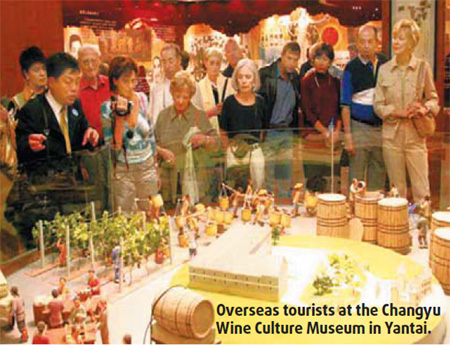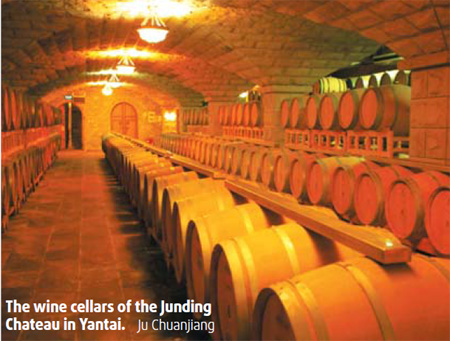Your are Here :Home> News>Biz Updates
Port city shifts from red wine to 'blue' tourism
Updated : 2009-09-10
(China Daily)
|
The coastal view of Yantai. Hou Heliang |
Red is the colour most frequently associated with Yantai, due to the ever-popular Changyu wine sourced from the region, but that may change - if the city succeeds in its bid to become a "blue tourism" resort.
Yantai, the largest seaport in the northeastern Shandong province, is now looking to fully exploit its marine resources and establish itself as an international travel and leisure resort.
Explaining the move, Yin Guowen, director of the Yantai Tourism Bureau, said: "Yantai sees fully utilizing its coastal resources as crucial to building itself into an international tourism destination, and making the best use of its many unique features.
"The sea around Yantai is home to more than 50 islands. We also have a 300 km-long beach, part of our 900 km-long coastline that constitutes one third of the total length of Shandong's coast. The combination of these elements is sure to make Yantai a popular destination for holiday-makers from China and beyond."
In order to boost the prospects for its nascent tourism industry, the local authorities have drawn up a series of guidelines aimed at boosting its "blue tourism" offer. The adoption of these protocols will be a key part of its transition into a tourism-led economy.
During the first half of the year, some 12 million tourists came to experience the city, with around 172,000 of them coming from overseas. This represents a 15.24 and 3.78 percent respective increase over the same period last year. These visitors generated a total revenue of 11.88 billion yuan, again showing a year-on-year increase, this time of 16.94 percent.
The advent of the summer season gave the city's tourism initiatives added momentum. Its 41 major scenic spots welcomed 4 million tourists in July, an increase of a massive 63.3 percent over the same period last year.
Tourism advantages

Yantai was listed among the first tranche of Excellent China Tourism Cities in 1998. In the wake of this, the city's four prefecture-level counties - Penglai, Longkou, Qixia and Haiyang -- were also acknowledged as Excellent China Tourism Cities. The nearby Changdao island county has also been designated as one of the country's premier tourist destinations. All of these have made Yantai the most feted tourism destination in Shandong.
With its position as the resort of choice for visitors to Shandong now unequivocally established, the city has developed five provincial-level tourism sites, all set against stunning ocean and mountain backdrops.
Revenues generated by just four of the five sites - Jinshatan, Yangmadao, Penglai and Haiyang - are now estimated at 5.63 billion yuan per annum
With the "blue tourism" initiative set to become a reality, another eight coastal resorts are now at the planning stage.
Away from its coastal charms, the city has a number of inland attractions that have long proved popular with visitors.
These include a 100 km-long "grape belt", the source of its wine stocks, and an array of health-enhancing hot springs. Most popular of all, though, is its Nanshan Golf Club, which boasts 270 holes, making it the largest in the world. Last year, the golf club welcomed 175,000 players of which 134,000 were from overseas.
Besides its more recently introduced leisure facilities Yantai's cultural heritage is also a major highlight for visitors to the city.
During the time of the Tang Dynasty (AD 618-907), Dengzhou, a suburb of Yantai was the embarkation point for China's ancient "maritime silk road". To showcase its rich array of offshore relics, the Yantai authorities have constructed a dedicated aquatic sightseeing route, encompassing visits to the Penglai Pavilion, the Sanxian Mountain ("Three fairies Mountain") and the Kunyu Mountain.
Its rich tourism resources have made Yantai an attractive prospect for both Chinese and overseas investors.
Businesses from more than 20 countries and regions, including South Korea, Japan and Singapore, have to date signed 114 contracts with the city authorities, representing a total investment of 73.9 billion yuan in its tourism industry. Of these projects, 47 are already under construction, involving funding of 28.8 billion yuan.




